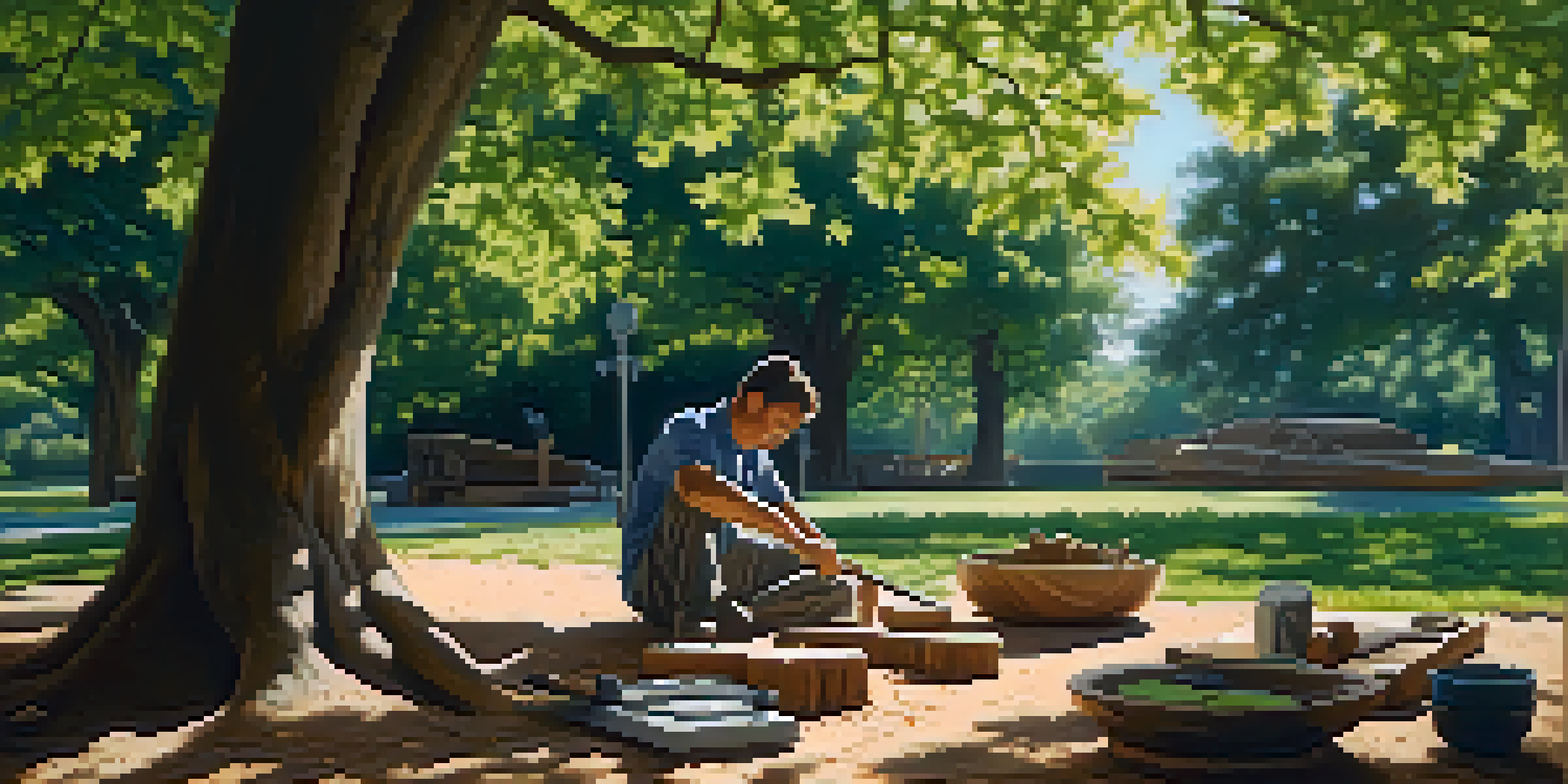Elemental Forces in Carving: Earth, Air, Fire, Water

The Foundation of Carving: Earth as an Element
Earth is often viewed as the backbone of carving, providing the raw materials that artists use to bring their visions to life. From stone to wood, the texture and density of earthly materials shape the techniques and tools employed by carvers. For instance, sculptors often choose softer woods for intricate designs, while granite might be selected for its durability in monumental works.
Art is the most beautiful of all lies; it is the truth that is hidden behind them.
The relationship between the artist and the material is crucial; understanding the properties of earth helps in predicting how it will respond to tools and techniques. This connection fosters a deeper appreciation for nature's offerings, as each piece of wood or stone carries its own story and character. By harnessing the essence of earth, artists not only create but also honor the raw beauty of their materials.
Additionally, the process of carving itself can be meditative, with each stroke connecting the artist to the earth. This mindfulness enhances creativity, allowing carvers to channel the energy of the ground beneath them. Ultimately, earth serves as a grounding force that inspires and shapes the art of carving.
Breath of Inspiration: Air's Role in Carving
Air is often overlooked, yet it plays a vital role in the carving process by influencing the environment in which the artist works. Fresh air can invigorate creativity, while stillness allows for focused attention on the task at hand. For example, artists working outdoors often find that the gentle breeze can spark fresh ideas, making their work more dynamic.

Moreover, air carries sounds, scents, and even temperatures that can inspire or distract a carver. The rustle of leaves or the distant sound of waves can evoke emotions that translate into the art being created. This sensory experience is essential, as it immerses the artist in a world that fuels their imagination and artistry.
Elements Shape Artistic Expression
The interplay of earth, air, fire, and water enhances the carving process by inspiring creativity and fostering a deeper connection to nature.
Lastly, the concept of air relates to the freedom of expression in carving. Just as air flows and adapts, so too can a carver explore various styles and techniques, allowing their creativity to take flight. This adaptability is crucial, as it encourages artists to experiment and evolve, ultimately enriching their work.
Ignition of Passion: Fire in the Carving Process
Fire symbolizes transformation and passion, making it a powerful force in carving. From the heat of a forge that shapes metal tools to the fiery spirit of an artist, fire ignites creativity and determination. For example, some carvers even use controlled fire to create unique textures and finishes on wood, demonstrating the element's versatility.
The artist is not a special kind of person; every person is a special kind of artist.
The energy of fire can also manifest in the artist's mindset, driving them to push boundaries and explore new horizons in their craft. This inner flame is essential for innovation, as it encourages carvers to take risks and challenge traditional techniques. The result is often groundbreaking art that resonates with viewers on a deeper level.
Furthermore, fire's ephemeral nature reminds artists of the importance of embracing change. Just as flames dance and flicker, so too can an artist's journey shift directions, leading to unexpected yet beautiful outcomes. This acceptance of transformation is key to artistic growth and fosters resilience in the face of challenges.
Fluidity of Creation: Water's Influence on Carving
Water, the element of fluidity, brings a unique dimension to the carving process. It can be seen in the way artists use water to soften materials like clay, allowing them to mold and shape their creations with ease. Additionally, water can be a source of inspiration, with its ever-changing forms and reflections sparking new ideas.
The calming presence of water can also create a serene environment for carving. Many artists find that being near water, whether a river, lake, or ocean, enhances their focus and creativity. The rhythmic sound of waves or the gentle flow of a stream can create a soothing backdrop that encourages a deeper connection to the art being created.
Cultural Roots in Carving Traditions
Many cultures honor elemental forces in their carving traditions, incorporating symbols and techniques that reflect their beliefs and values.
Moreover, water serves as a reminder of the cycles of nature, mirroring the artistic process itself. Just as water shapes landscapes over time, carving is an evolution that requires patience and persistence. Embracing this flow can empower artists to trust their instincts and allow their work to develop organically.
Harmony of Elements: Integrating Earth, Air, Fire, and Water
The true magic of carving lies in the harmonious interplay of earth, air, fire, and water. Each element contributes its unique qualities, creating a balanced approach to artistic expression. For instance, a carver might use earthy materials shaped by fire, inspired by the air, and softened by water, resulting in a piece that embodies the essence of all four elements.
This integration not only enriches the creative process but also allows for a more profound connection to nature. By recognizing the influence of these elements, artists can cultivate a deeper understanding of their craft and develop a more cohesive style. This holistic approach results in works that resonate with viewers, evoking emotions that reflect the magic of nature.
Ultimately, embracing the elemental forces fosters growth within the artist. As they navigate the challenges and joys of carving, they become more attuned to the rhythms of life and nature. This journey not only enhances their skills but also transforms their art into a reflection of the world around them.
Cultural Significance: The Elements in Carving Traditions
Throughout history, various cultures have revered the elemental forces in their carving traditions. Many indigenous communities view earth, air, fire, and water as sacred elements that embody life and creativity. For instance, Native American totem poles often depict animals associated with these forces, serving as symbolic representations of their beliefs and values.
In Asian cultures, the art of carving often reflects the balance of elemental forces, with intricate designs that embody harmony and nature. Chinese stone carvings, for example, frequently incorporate water motifs, symbolizing fluidity and adaptability. This rich cultural significance adds layers of meaning to the art, connecting the viewer to a broader narrative.
Sustainability in Carving Practices
The carving community is increasingly focused on eco-friendly materials and techniques, promoting sustainability and respect for the environment.
Recognizing the cultural context of these elements allows contemporary artists to draw inspiration from past traditions. By incorporating ancient techniques and symbols into their work, modern carvers can create pieces that honor their heritage while also exploring new avenues of expression. This fusion of old and new enriches the art form, making it a living testament to the power of the elemental forces.
Environmental Impact: Sustainability in Carving
As the world becomes more aware of environmental issues, the carving community is increasingly focused on sustainability. Artists are seeking out eco-friendly materials and practices that align with their values, ensuring that their work respects the earth. For instance, using reclaimed wood or responsibly sourced stone minimizes the impact on natural resources.
Additionally, many carvers are exploring techniques that reduce waste, such as utilizing off-cuts for smaller projects or integrating natural elements into their designs. This mindful approach not only benefits the environment but also adds a unique character to the artwork, as each piece tells a story of sustainability and respect for nature.

By embracing sustainability, carvers can inspire others to consider their ecological footprint. This shift not only promotes awareness but also encourages a deeper connection between the artist and the materials they use. Ultimately, the commitment to sustainability transforms the carving process into a celebration of the earth, air, fire, and water that sustains us all.